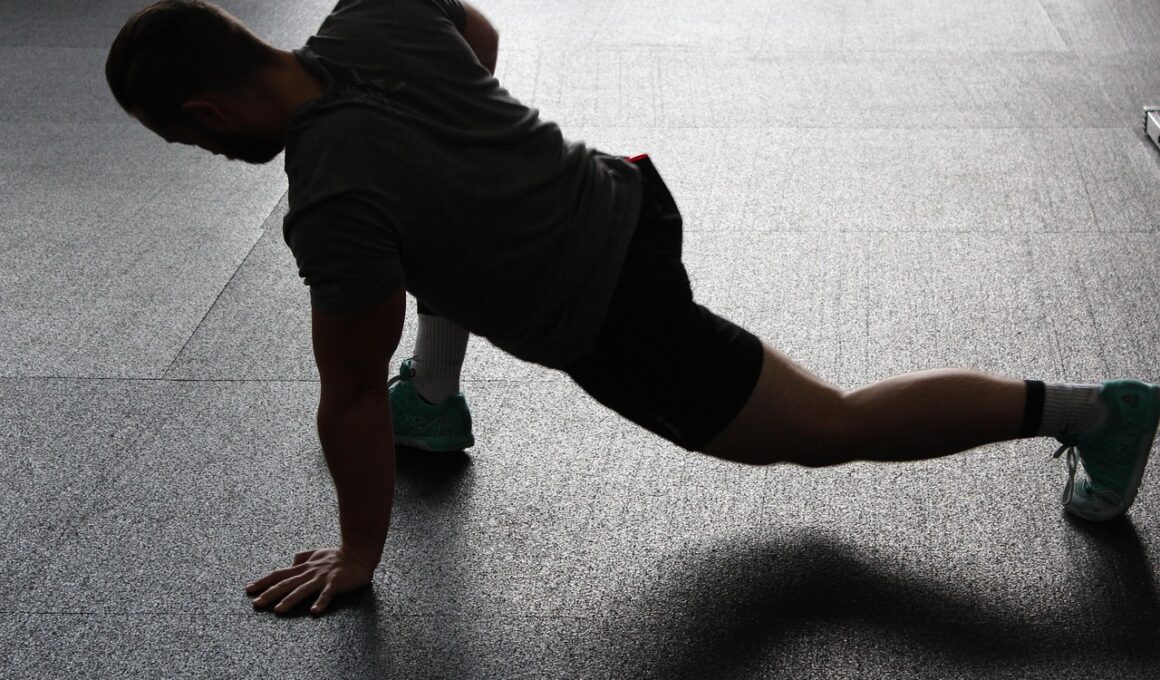Warm-Up Strategies to Prevent Injuries in Kickboxing
Kickboxing is a physically demanding sport that requires proper warm-up routines to minimize injury risks. A well-structured warm-up should target the muscles used during training and improve overall performance. Effective warm-up routines typically include dynamic stretches, mobility exercises, and sport-specific movements. Dynamic stretches like arm circles, leg swings, and torso twists increase blood circulation to muscles and joints, preparing them for activity. Incorporating mobility exercises helps enhance flexibility and range of motion, crucial for executing various kickboxing techniques. It is essential to focus on areas commonly prone to injuries, such as the shoulders, hips, and knees. Engaging in light cardio, like jogging or skipping, signals your body that it’s time to work. Thus, elevating the heart rate and preparing your cardiovascular system for intense activity should be emphasized. Kickboxers should design a warm-up routine keeping in mind their skill level, physical condition, and potential injury history. A personalized warm-up not only enhances performance but also safeguards against injuries during training or competition. Always consult a coach for tailored advice on effective warm-up techniques.
Incorporating strength and conditioning exercises into your warm-up can further enhance its effectiveness. These exercises, such as bodyweight squats, push-ups, and lunges, build strength and stability in key muscle groups. A warm-up that combines mobility work with strength-building not only prepares the body physically but mentally. Understand the importance of focusing on your core, as a strong core aids in balance and stability during kicks and punches. Aim to strengthen the core while maintaining proper form throughout exercises. Also, consider incorporating resistance bands for added challenge and engagement of muscles. Adding some skill-based drills like shadow boxing can boost coordination and technique awareness. This can psychologically prepare you for training or competitions, enhancing confidence levels. Moreover, practicing footwork drills in the warm-up sets the tone for agility and control, allowing faster responses during sparring or fighting. Therefore, your warm-up should reflect the intensity of your kickboxing session. Be attentive to how your body feels during these exercises and adjust accordingly. Emphasizing both mental and physical readiness will promote a successful training experience with reduced injury risks.
Hydration should not be overlooked when planning your kickboxing warm-up routine. Adequate hydration is essential for optimal muscle function, joint lubrication, and overall performance. Before beginning your warm-up, make sure to drink water or a sports drink to replenish fluids, especially in hotter conditions. Electrolyte balance is vital, as kickboxing can lead to significant sweat loss. Implement hydration strategies throughout your training program. This includes sipping fluids during breaks to maintain performance levels effectively. Enhancing your warm-up with proper breathing techniques can also drastically affect performance. Controlled breathing helps stabilize the cardiovascular system and manage anxiety. Techniques such as diaphragmatic breathing provide oxygen-rich blood flow to muscles during the warm-up period. Incorporate breathing exercises before diving into more strenuous movements. It is recommended that kickboxers spend a few minutes focusing on their breath to enhance lung capacity. This preparation is instrumental in improving your endurance during workouts. Remember, your warm-up serves as the foundation for your training, so prioritize adequate hydration and breathing techniques to elevate your performance while minimizing the risk of injury.
Progression and Customization
The structure of your warm-up should adapt to individual progress and training specifics. As you become more experienced in kickboxing, your warm-up should evolve accordingly. Novice kickboxers may require more fundamental movements to develop proprioception and basic coordination. Conversely, more experienced athletes should focus on refining advanced techniques and enhancing overall explosiveness during their warm-up. This progressive approach ensures that warm-up routines remain relevant and beneficial. Be mindful of personal factors such as age, fitness level, injury history, and individual goals when customizing your warm-up strategy. Tailoring these routines can lead to better performance outcomes and improved injury prevention. Conduct self-assessments studying how your body feels in response to different exercises. Frequent adjustments to your routine are essential to maintaining motivation and addressing specific needs. Regularly consult with coaches to explore new warm-up methods or modification suggestions that can help accommodate your journey. Together with your coach, devise a comprehensive warm-up that combines flexibility, mobility, strength, and coordination components suited to your level. Ultimately, maintaining variety in your warm-up helps keep your training regimen fresh and engaging.
The environment in which you warm up also plays a critical role in injury prevention. Ensure that your warm-up space is safe, free of hazards, and has adequate room to perform dynamic movements. Choosing an appropriate area equipped with cushioned flooring can reduce injury risks from impact. Maintain consistent warmth in your muscles throughout the warm-up period. Cold environments can lead to stiffness, so consider warming up in a controlled climate when possible. The timing of your warm-up relative to the main training session is another consideration; warming up too soon may result in loss of body heat. Aim to synchronize your warm-up closely with the start time of your kickboxing practice or competition. Paying attention to these elements can significantly enhance the effectiveness of your warm-up. Furthermore, practice rallying your mind toward the upcoming session. By focusing mentally on your goals, whether competition or training, you’re fostering a proper mindset for success. Engaging in a strong mental approach will boost your readiness and commitment during both physical exertion and recovery, ultimately protecting against injuries that may arise under pressure.
Consistency and Recovery
Adopting a consistent warm-up routine is crucial for kickboxers of all levels. Regularly implementing warm-ups helps reinforce muscle memory while preparing the body for intense workouts. Establishing this habit ensures that your body recognizes the significance of warm-up protocols before training sessions. Consistency creates a psychological link that signals the body it’s time to perform at peak levels. Along with a warm-up routine, prioritize post-training recovery strategies to complement your injury prevention efforts. Incorporating cool-down exercises, stretching, and proper nutrition post-session supports muscle recovery and helps prevent injuries. Techniques such as foam rolling can alleviate muscle tightness, ensuring your body returns to its ideal state. Additionally, permit time for adequate rest between training sessions to avoid overtraining or excessive fatigue. Explore sleep hygiene practices and nutrition that aid recovery from intense kickboxing workouts. By taking care of your body post-workout, you help ensure that it is ready for the next training session. Structure your overall training plan to balance not just warm-up and workout routines but also recovery strategies that align with injury prevention, promoting longevity in your kickboxing journey.
In summary, effective warm-up strategies are vital for preventing injuries in kickboxing. Integrating dynamic stretching, strength exercises, mobility work, and proper hydration enhances physical preparations. Mental readiness through various techniques further supports performance and reduces anxiety. Ensure your warm-up routine evolves alongside your progress, keeping it attuned to your skill level and specific needs. Consistency in executing your warm-up protocols is essential, as is practicing regular post-training recovery strategies. Staying aware of environmental factors, safety, and overall well-being leads to improved readiness during training and sparring sessions. Emphasizing these elements ensures that you and fellow kickboxers experience exciting, injury-free workouts, promoting longer-term participation in the sport. By customizing routines and consistently applying them, kickboxing participants can build strong foundations for skill development, physical performance, and mental acumen. It is imperative to work collaboratively with coaches for expert input during warm-up design and adaptation. Ultimately, making injury prevention a cornerstone of your kickboxing training will contribute not only to personal improvement but also to long-lasting enjoyment within this dynamic martial art. Engage with your training community and discover best practices to elevate everyone’s kickboxing experience.
Overall, remember that the journey of improvement in kickboxing is ongoing. With each training session, there are opportunities to learn and grow. Embrace the gradual process, understanding that every phase adds to your skill set. Focusing on warm-up strategies is just as significant as mastering new techniques or competing. As you foster awareness and dedication to these warm-up routines, you’ll recognize their lasting benefits in performance and injury resilience. Commit to making each session count and approach every aspect of training with an open mind. By seeking knowledge and adapting your warm-up strategies, you can enhance your effectiveness during kickboxing workouts. Adherence to these routines will support a swift recovery, ultimately paving the way for greater successes while minimizing injury risks. Take into account how these warm-up sessions create a sound foundation for future improvements. Thus, consider kickboxing not only as a sport to master but also as a holistic health and wellness journey. Remember, your continuous commitment to advancing your skills translates directly into success in the ring. Grow as a kickboxer, taking control of your performance and well-being, and reap the rewards.


